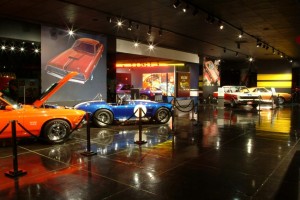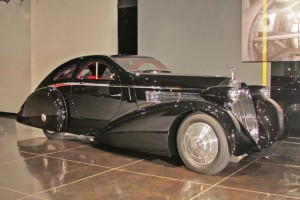Even with one less zero it would have been a significant chunk of change, but at $100 million, the “wonderful, generous” donation announced by the Petersen Automotive Museum is expected to secure its future and expand its displays significantly.
Opened in 1994 by the late magazine publisher Robert E. “Pete” Petersen, the museum has had plenty of struggles over the years, especially when it was operated as part of the Los Angeles County government. Petersen rescued the museum shortly before his death in 2007. But the new donation takes things to a whole new level.
The donation by his widow, Margie, and the Margie and Robert E. Petersen Foundation actually consists of three components collectively valued at $100 million, explained Buddy Pepp, the museum director:
- The 300,000 square-foot museum building, on Wilshire Blvd., at one of the busiest intersections in Los Angeles;
- Petersen’s personal collection of approximately 135 vehicles housed in the building but not available, until now, for public viewing;
- And what Pepp would only describe as a “monstrous” check.
Among the many new models from that the museum will now be able to roll out of the “vault” are a Tucker, a Stutz, four Duesenbergs, three Bugattis, a “lot” of Ferraris and what Pepp describes as possibly the most valuable Rolls-Royce in the world, the 1925 “Round Door” Rolls that was a star of the annual Pebble Beach Concours d’Elegance several years ago.
The cash portion of the donation will be used for some “much-needed maintenance and repairs,” and to create a permanent endowment for the museum, something that wasn’t in the cards when publisher Petersen first set up the facility in an old department store 17 years ago. Initially, the Petersen Automotive Museum operated as part of the Los Angeles County museum system, but it was continuously struggling for cash and, at one point, seemed doomed to close. Petersen stepped in, before his death, setting up an independent board and pumping in enough cash to keep the operation going.
But with the new infusion, the museum now has, “more than a chance to breathe,” said Pepp. “My great-great-grandchildren will be able to visit the museum. The future is absolutely secure.”
It’s not just Pepp’s heirs who will be pleased by the news. The museum typically hosts more than 150,000 paying visitors every year – plus as many as 8,000 local students who are bussed over as part of a program funded by Margie Petersen.
The Petersen Automotive Museum Board will now be nearly doubled in size, according to Pepp, who promises some “big names” will be added as part of the effort to expand the facility’s offerings thanks to the new donation.


